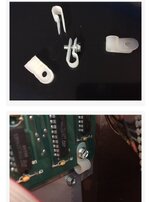I have some notes I cant claim any credit for them as I saved part of these from a post by Brett the XPIN designer and Viperrwk, All I would add is to make sure that the voltage of any capacitors you replace is the same (or greater) than the originals)
---------------------------------------------------------------------------------------------------------------------------------------------------------------------------------------------------------------------------------------------------------------------
The original DE power supply creates a +12 and -12 unregulated DC voltage. For those who don’t know what an unregulated supply is, it is a rectified AC voltage is turned to DC and filtered with a big bulk capacitor. On the +12, the supply has 18000uf and the -12 has a 1000uf cap. The reason behind the 18000uf on the +12 is that this +12 is the input voltage for the +5V rail. If you replace both of these caps, the hum should be reduced. My recommendation is that to replace both with a larger capacitance value. These caps are bulk storage caps. They will decrease the ripple feeding into all of the downstream regulators. Simulations show increasing the 18000uf to 22000uf and the 1000uf to 1200 uf should increase the downstream regulator effectiveness by ~15%. Age and use have been working against us on these caps.
This is probably the biggest culprit in generating the hum. The DE soundboard design takes the +/-12 V unreg DC and passes them to 7805(+5) and 7905(-5) linear regulators. The inputs to these regulators also have 470uf caps on them. In theory, what should happen is that they will work in conjunction with the bulk caps on the power supply board which should reduce the ripple even more. Solid theory, but there is more to this story.
In the mid-90’s most mfgs of 7805 and 7905 devices stated that they needed a minimum input voltage of at least 8-9 volts to maintain regulation. As far as linear regs go this is fine for the era. Modern equivalents claim they only need 7vdc to maintain regulation. If the ripple drops below the regulation point, the output of the linear will sag as well, so you now will have a 120hz signal on your output of the regulator.
The +/5V rails are fed into LM833 opamps, which will then transfer the 120 hz ripple into the MB3730 audio amplifier. I believe this is how the hum is getting there.
My recommendation for the sound board is to replace the 470uf (C31 and C52) caps on the inputs of these regulators with at least 1000uf caps. This gives you fresh caps, the increased capacitance will reduce ripple, which considering the age of the board, will allow it to keep the input voltage at a higher point, compensating for the higher electrical load caused by older components.
I would also recommend replacing the bulk caps on U31, U32, and U33. Primary power for these devices is the +12V regulated rail from the power supply. These caps (C60, C67, C74) should be replaced with the original value of 470uf.
The DMD display can have an impact on the hum as well, but only if it is a Babcock Plasma display. Why only Babcock? Babcock displays require 12V to operate which in DE games it gets from the power supplies regulated +12V. The internal structure of the SN75555 HV shift register used for driving the display counts on a stable +12V to properly bias internal transistors. Over time, I believe some degradation has also occurred with these parts because in theory, if the +12V is not rock solid, the ripple from the HV rails (60hz) can be induced on the +12V which can then be passed back to every device in the game using the +12V regulated rail, which includes the audio amps on the sound board.
Replacement of the 47uf cap at C18(?) should help this. I recommend a 100uf. No guarantee on this one because this path is also dependant on degradation of the SN75555 devices over time as well.
Not much more to add other than I believe we are fighting an age issue. Keeping in mind that these games are 20yrs old, the electronics are feeling their age. A little refresh is always a good thing.





